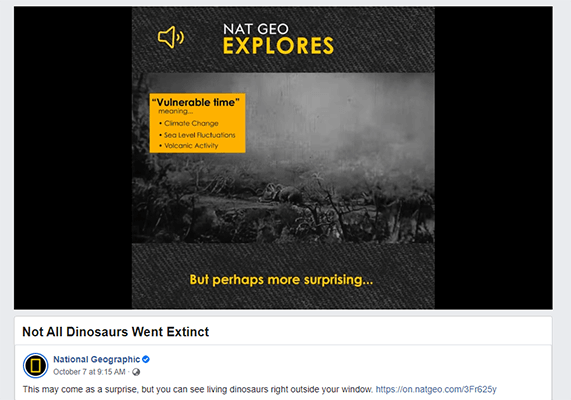The Best Time To Post On Facebook According To Data
What is the best time to post on Facebook? And what other factors should you consider when planning your posting schedule?
In this post, we’re breaking down all of the research to help you answer that question. These insights will help you build a better social media strategy.
What is the best time to post on Facebook?
The answer can be confusing since it will vary depending on the source. Let’s see what the experts have to say about it.
Sprout Social
Based on data as recent as 2020, Sprout Social found that Facebook had round-the-clock engagement. It seems like Facebook users are on the platform regardless of the time of day.
This is great news for brands as it gives them a wider window on when they could publish their content.
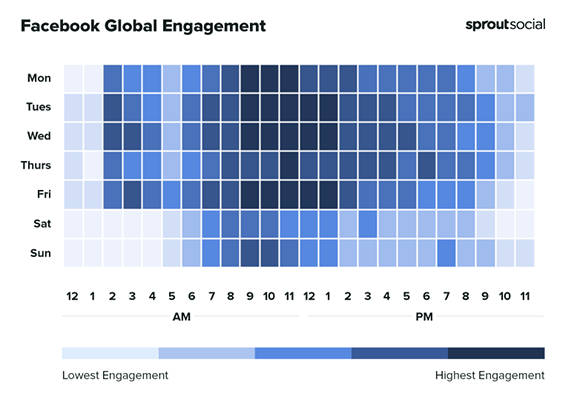
But it would appear that Tuesdays, Wednesdays, and Fridays between 9 AM and 1 PM (Central Standard time) are the best times to post on Facebook.
You don’t want to schedule your posts on Saturdays since that’s when posts seem to perform the worst.
Buffer
Buffer did its own research which contradicts what Sprout Social said. While it still recommends that users post on weekdays, it says the best times to post on Facebook are anytime between 1 PM and 3 PM.
It further reports that audience engagement increases by as much as 18% on Thursdays and Fridays.
Unlike Sprout Social, Buffer found that Saturdays are great for publishing your posts.
Hootsuite
Hootsuite has its own take on when you should post on Facebook. According to its analysis, you should post on Tuesdays and Thursdays from 8 AM to 12 PM.

Its own social media team found similar results with them recommending users to post on weekdays from 6:15 AM to 12:15 PM (PST).
The best time to post based on industry
CoSchedule goes a little deeper into its recommendations by stating which times are better to post Facebook updates based on the industry your business belongs to.
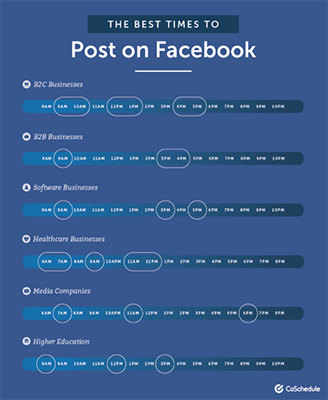
If you’re in the B2C market, then you could schedule your post at any time throughout the day. That’s because your target market will generally log into Facebook whenever they have free time on their hands.
However, CoSchedule’s team saw increased user activity during these times: 9 AM to 10 AM, 12 PM to 1 PM, and 4 PM to 5 PM.
Those that are in B2B businesses would have better results if they scheduled posts from 9 AM to 4 PM (with 3 PM to 4 PM being the best time).
The healthcare industry’s target audience will be more receptive in the mornings. CoSchedule says that during the afternoon, users will more likely use Facebook to entertain themselves rather than improving their health. You can schedule healthcare-related posts between 6 AM and 7 AM.
As for software companies, you can post before and after work hours. It’s almost the same for media companies. Those in higher education might want to try posting around noon.
Other factors that affect posting schedules
Even if you find an ideal time to post your Facebook content, there are other factors that could affect your campaign’s success.
Let’s talk about a few.
Geography
If you’re targeting a global audience, then you’ll have a harder time figuring out when to schedule your posts.
Even if you’re only focusing on the US market, you’d still have to deal with different time zones.
This is one of the reasons why it’s challenging to rely on Facebook research using third-party data. Their audience isn’t the same as yours. They should be treated as guides, not rules.
Posting frequency
Even if you post at the right time, if you don’t do it as often then you won’t see the results that you’re looking for.
However:
Posting too many times per day or week will likely push your followers away—or worse—use it as a reason for unfollowing your brand.
That’s why you’ll need to strike the right balance. We suggest using a social media analytics software or tool that’ll give you a clear picture of how many posts are acceptable to your audience.
When you see your number of followers start dropping off, consider pulling back on posting frequency.
Consistency
Consistency—not just in scheduling posts but in content quality as well—is one of the keys to getting high engagement.
Let’s start with content quality. If your posts look like they’ve been written by different people, then your audience might not stick around for too long. If your followers are used to getting well-researched tips from your account then all of a sudden you stop, they’ll have no reason to follow your account any longer.
When it comes to timing, you want to post around the same times and days of the week. If people get used to receiving updates while they’re having breakfast or morning commute, your posts will become a part of their routine — which is good for business.
Content types
Content types should be a significant consideration within your social media strategy.
You’ll need to consider developing a mix of content that supports several goals. Primarily, content that builds your audience should be your focus. But you’ll also need to publish content to drive traffic to your own platforms.
However, this can be challenging due to how Facebook’s algorithm works. The algorithm is designed to favour content that keeps users on their platform. So, you should expect that content types such as Facebook videos will be more effective at building an audience than sharing external links to your content.
How to get better user engagement on Facebook
The days and times you post your content does have an impact on user engagement. But it’s not the only way to get more likes, shares, and comments.
There are plenty of proven ways that’ll get you more engagement from your Facebook audience. Below are just a few of them.
Expand your content
As an entrepreneur, you can only talk about your products for so long. There’ll come a point when your audience will get bored of seeing the same posts over and over.
See, that’s one of the mistakes that businesses make. They think social marketing only refers to pushing goods and services. But with Facebook, you have the option to explore all types of content.
Instead of posting photos of your products, why not feature the people who work behind the scenes instead? You can also do livestreams to get to know your community a little better.
You can launch polls, do Q&As, and upload behind-the-scenes videos of your business. There are so many things you could do on Facebook to encourage user participation.
For example, Tasty’s posts don’t focus solely on promoting their videos and products. They also ask questions that encourage participation from their community.
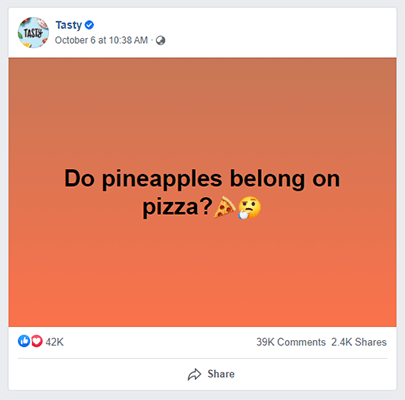
That’s right! A question about whether or not pineapples belong on pizza has 39,000+ comments and 2,400+ shares. Even you can get that kind of engagement if you ask the right question to your community.
Alternatively, you could look at other types of interactive content such as online quizzes and giveaways.
Remember – anything that encourages engagement while keeping users on the Facebook platform will typically perform better.
Find out what’s working for you
If you’ve been publishing content on Facebook for a while, you’ll realize what types of posts your followers like to see. So use this information to come up with a better content strategy.
You should push content that gets a positive response while slowly phasing out posts that users don’t appreciate as much.
This Fitbit post shows that the brand is focusing on delivering self-care tips and tricks while injecting humor along the way.
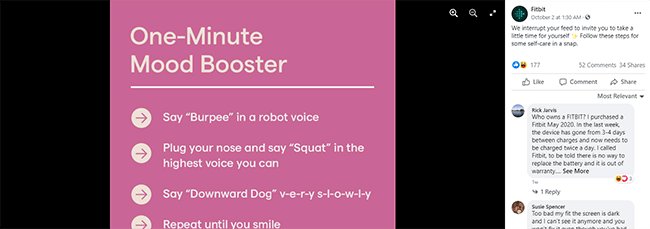
You’ll know which ones work through shares, likes, and comments. You can also use social media analytics tools to see which posts get the most reach and reactions.
Use better photos
It’s always a good idea to use high-quality photos when you create posts for Facebook. You don’t need professional camera gear to generate good photos. Phone cameras today are so advanced, they can go toe-to-toe with mid-range cameras and lenses.
What you do need are great concepts, some creativity, and basic photo editing skills.
Including strong visual content will result in consistent engagement.
And while we’re on the subject, you should use original photos when you post content on Facebook. Not only will doing so protect you from copyright issues, but it will also be good for your brand.
Talk with your followers
To get the most engagement, you should learn how to return the favor. What do we mean by that? Try your best to respond to as many comments and messages as possible.
If you have people wanting to interact with your brand, then it’s only fitting that you respond to their questions, suggestions, and concerns.
For direct messages, you can actually use bots to respond to frequently asked questions. Auto-replies make sure that your fans don’t feel left out when they drop you a message.
Add a call to action
Sometimes you have to talk people into taking action after reading your post. It doesn’t have to be direct; You can be subtle about it. For example, leaving a provocative question will lead people to leave a comment to share their opinion.
But there’s nothing wrong with telling people to tag people who’d benefit from reading your post or to hit the like button if they agree with your thoughts.
And if you’re an e-commerce business, you can add a link going to your product pages along with a nudge for your audience to check out your site. Some of them might leave a comment about your product if they like what they see.
All of these will help improve your engagement rates.
Be concise
There’s no reason to keep rambling, especially if you can make your point in a few short sentences. Remember: People on social media have short attention spans. If your post looks lengthy, users will probably scroll past it.
Make sure your posts are easy to digest.
Upload videos
Uploading videos to Facebook directly is better for discoverability. And the more people see your videos, the better it will be for your user engagement numbers.
For example, National Geographic has long been known for its amazing videography. But it’s still continuing to experiment with different video formats and uploading them directly to Facebook.
On a related note, doing live broadcasts is a great way to interact with your community. So make sure you do it regularly.
Publish informative content
Aside from ads, you can publish informative content that users will find valuable. For example, you can upload tutorials, how-to videos, seminars, and motivational speeches.
In this post from GoPro, they use photos to draw users in before promoting a blog post that shares the best tips for landscape photography.
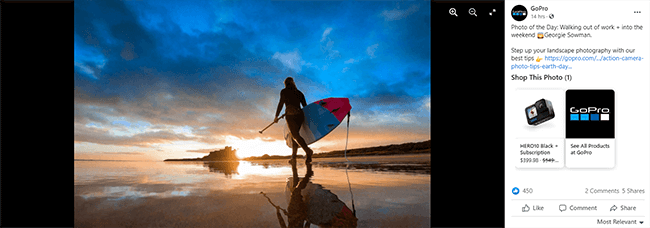
Give them content that will improve their lives or business in some way.
Humanize your brand
It’s easy to forget that as a brand, you don’t have to push your products all the time. You don’t want your followers to treat you like a robot. They want to see a real person working behind the scenes. Simply put, they want to interact with a real person.
And you can do that through your social media posts.
Show your team working behind the scenes. Tell people how you help your community outside of work. And if you’re bold enough, share with people some of the struggles you’re facing. Vulnerability isn’t a bad thing if it humanizes your brand.
Conclusion
According to different sources, the best days to post are during the early morning to early afternoon on weekdays.
However:
This should only be used as a guide. The only way to know for certain when you should publish Facebook posts is to use data based on your audience engagement rate.
But don’t forget that the types of content you publish are important as well. They can have a dramatic impact on the amount of engagement your Facebook Page receives.
Related Reading:
- The Best Time To Post On Instagram
- The Best Time To Post On Twitter
- The Best Time To Post On LinkedIn
- The Best Time To Post On TikTok
- 40+ Social Media Statistics Marketers Should Know
- How To Create A Social Media Strategy
- 25 Latest Social Selling Statistics And Trends
Disclosure: If you buy through links on our site, we may make a commission. This helps to support the running of Startup Bonsai.

